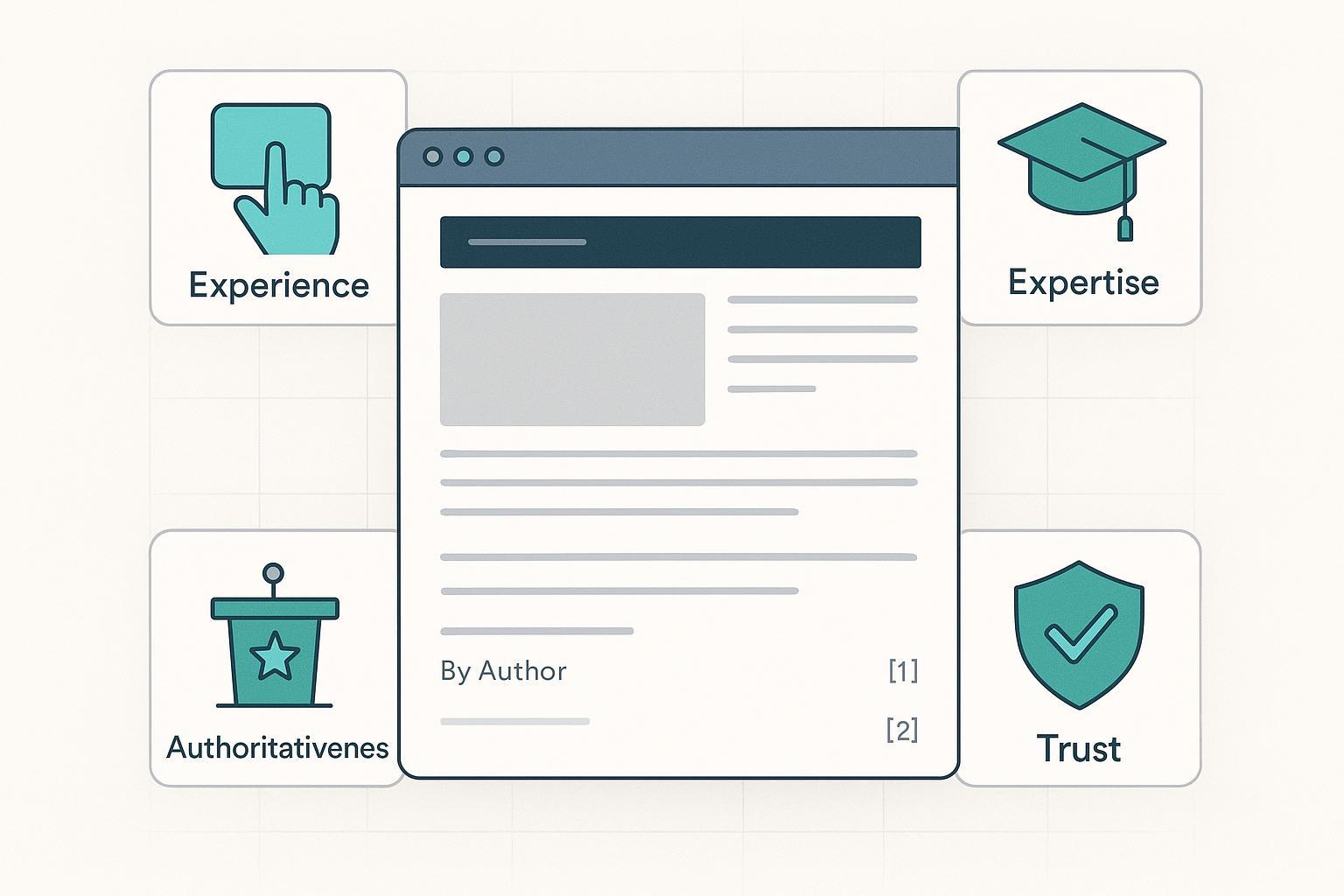What Is E‑E‑A‑T and How to Improve It: A Practical Guide

Would you trust a doctor whose office has no name on the door, no diploma on the wall, and no records of past patients? Online, readers (and Google’s systems) ask similar questions about your pages. That’s where E‑E‑A‑T—Experience, Expertise, Authoritativeness, and Trustworthiness—comes in.
This guide explains what E‑E‑A‑T is (and isn’t), how it shows up on a page and across your site, and a practical plan to improve it with clear, measurable steps.
What E‑E‑A‑T Really Means
E‑E‑A‑T is a quality lens Google uses to describe content that its systems aim to reward: helpful, reliable, people‑first pages that demonstrate real‑world experience, credible expertise, recognized authority, and trust. Google emphasizes this is a framework, not a single ranking factor; multiple systems and signals—mostly at the page level—work together to evaluate quality and relevance, as noted in the March 2024 explanation of core systems and spam policies in Google’s “Core update and spam policies” post.
Human quality raters use the Search Quality Rater Guidelines (current PDF) to evaluate how well Google’s systems are doing. Their ratings don’t directly change your site’s rankings, but the guidelines clarify what “high quality” looks like and put Trust at the center—especially for sensitive topics often called YMYL (Your Money or Your Life).
A practical way to align with this framework is Google’s people‑first content approach—the “Who, How, and Why” lens—described in Google’s guidance on creating helpful, reliable content. Identify who created the content, explain how it was produced, and be clear why the page exists (to help people, not to manipulate rankings).
Show It on the Page: Who, How, and Why
Think of the page as your storefront. Readers should immediately understand who’s speaking, how the information was gathered, and why it deserves their time.
Who created this?
Use visible bylines on articles and link to robust author bios. A strong bio ties the topic to the author’s relevant background—years in the field, certifications, portfolios, and contact or profile links. For organizations, help readers (and machines) disambiguate your brand and people with consistent naming and profile pages.
How was it produced?
Explain your method in plain language. If you tested products, describe the setup, criteria, and limitations. If you analyzed data, share sources and how you cleaned or interpreted the dataset. Include first‑hand evidence—original photos, screenshots, and short video clips—so readers can see the work. Add dates for when a page was published and last updated, and keep a brief revision note on important pages.
Why does it exist?
Make the intent obvious: solve a problem, compare options, teach a skill. Disclose any affiliations or sponsorships, and keep ads/affiliate elements clearly secondary to the main content.
Below is a quick reference to concrete on‑page proofs readers expect.
| Signal | What to show | Example |
|---|---|---|
| Who (Authorship) | Visible byline linked to an author bio with relevant qualifications and ways to verify identity | “By Jane Patel, RN – 8 years in oncology nursing; LinkedIn; publications” |
| How (Method) | A short methods section outlining research/test steps and data sources | “We timed each router’s setup, ran 3 speed tests per room, and logged stability for 7 days.” |
| First‑hand evidence | Original photos/screenshots or recordings from your testing or use | Photo of your meter during testing; screenshot of settings used |
| Sourcing | Inline citations to primary or authoritative references; clear publication/updated dates | Links to original guidance, standards, or peer‑reviewed work; visible “Updated on” date |
| Disclosures | Affiliates/sponsorships and any conflicts of interest | “We may earn a commission from links; this doesn’t affect test scoring.” |
| Expert review (when needed) | For sensitive topics, add a reviewer’s name, credentials, and what was reviewed | “Medically reviewed by Dr. Luis Gómez, MD—treatment sections verified for accuracy.” |
A higher bar for YMYL topics: If your content can affect someone’s health, finances, legal status, or safety, raise the standard. Use qualified authors or explicit expert review, cite primary sources, and maintain a visible update and corrections history. The SQRG details these expectations for YMYL topics and how raters evaluate trust.
Site‑Level Trust Foundations
Great pages sit on a trustworthy foundation. Make it effortless for people to understand who you are and how to reach you.
Publish a clear About page and a real Contact page (email, form, and if relevant, phone or physical address). Show ownership/leadership and, for businesses, customer support paths. Document editorial and corrections policies, privacy policy, and terms, and keep them easy to find in the footer and from key pages. Serve the site over HTTPS and keep security hygiene in order—readers notice padlocks; browsers do, too. Maintain brand consistency so names, logos, and author identities match across site sections and social profiles. Finally, use structured data to clarify who the publisher and creators are and connect content to profiles; Google’s structured data documentation shows how to mark up Organization, Person, Article, and creator profile pages.
Page Experience Supports Trust
Page experience isn’t a single “score,” but it strongly influences whether readers stay. Make content easy to read, fast to load, and stable on mobile. Focus on a clear layout and typography with generous spacing, mobile‑first design with accessible contrast, and performance basics that align with Core Web Vitals: keep Largest Contentful Paint quick (fast first view), Cumulative Layout Shift low (no jarring shifts), and Interaction to Next Paint snappy (responsive taps and clicks). Avoid intrusive interstitials and overly aggressive ads. If your monetization competes with the main content, trust erodes. Google’s page experience overview explains these supportive signals and how they relate to helpful content.
Want a simple test? Hand your phone to a colleague and ask them to complete a task on your page. If they stumble, readers will, too.
AI‑Generated Content: Quality Over Method
Google has stated it evaluates the quality and helpfulness of content rather than how it was produced. Appropriate use of automation is allowed; what violates policy is using automation primarily to manipulate rankings or to mass‑produce thin pages. If you use AI, keep human oversight for accuracy and context, disclose where it helps readers, and ensure the final page still shows real experience and expertise. See Google’s guidance about AI‑generated content for the official stance.
A Prioritized Action Plan (6 Weeks)
- Week 1–2: Add visible bylines and linked bios to key pages; publish or refresh About and Contact; surface privacy, editorial, and corrections policies; enforce HTTPS site‑wide.
- Week 3: Add citations, updated dates, and short “How we researched/tested” sections to your top‑traffic and YMYL pages.
- Week 4: Create or improve author profile pages and connect them to articles; align names and identities across the site and social profiles via structured data.
- Week 5: Capture first‑hand evidence—photos, screenshots, short clips—and add them to product reviews, tutorials, and case studies.
- Week 6: Improve page experience: compress images, fix layout shifts, and address long tasks that slow interaction; reduce intrusive interstitials and clarify affiliate disclosures.
- Ongoing: Establish expert review for YMYL content, schedule periodic updates, and monitor for policy hygiene (no scaled low‑value pages, no site‑reputation abuses).
Make It Measurable
- Coverage: Percent of pages with visible bylines and linked bios; percent with publication and updated dates.
- Evidence density: Share of pages with first‑hand photos/screenshots and a short methods section.
- YMYL compliance: Proportion of YMYL pages with expert authorship or an expert review stamp; time‑to‑review after guideline changes.
- Reputation: Count of new high‑quality mentions/citations per quarter; growth in expert profiles or speaking appearances.
- UX support: Share of traffic meeting Core Web Vitals thresholds; user feedback on readability and ad intrusiveness.
- Policy hygiene: Discoverability of privacy/editorial/corrections policies; consistency of ownership and contact information.
Common Misconceptions and Risks
- “E‑E‑A‑T is a direct ranking factor.” It’s a framework for qualities Google’s systems aim to reward, not a single toggle.
- “AI content is penalized.” Method isn’t the issue; quality, intent, and policy compliance are. Human review still matters.
- “Core Web Vitals alone will lift rankings.” Good UX helps retention and trust, but relevance and quality come first.
- “A few bios will fix everything.” E‑E‑A‑T is holistic: on‑page proofs, site foundations, reputation, and ongoing maintenance.
- “Any link counts as authority.” Manipulative linking risks penalties; earned mentions and genuine citations build durable authority.
Here’s the deal: E‑E‑A‑T is not a checkbox—it’s an operating system for trustworthy publishing. Start with clear authorship and methods, shore up site‑level policies and identity, add first‑hand evidence, and keep improving page experience. Then measure relentlessly. What would a skeptical reader need to see to believe you? Make that visible, and keep it current.

